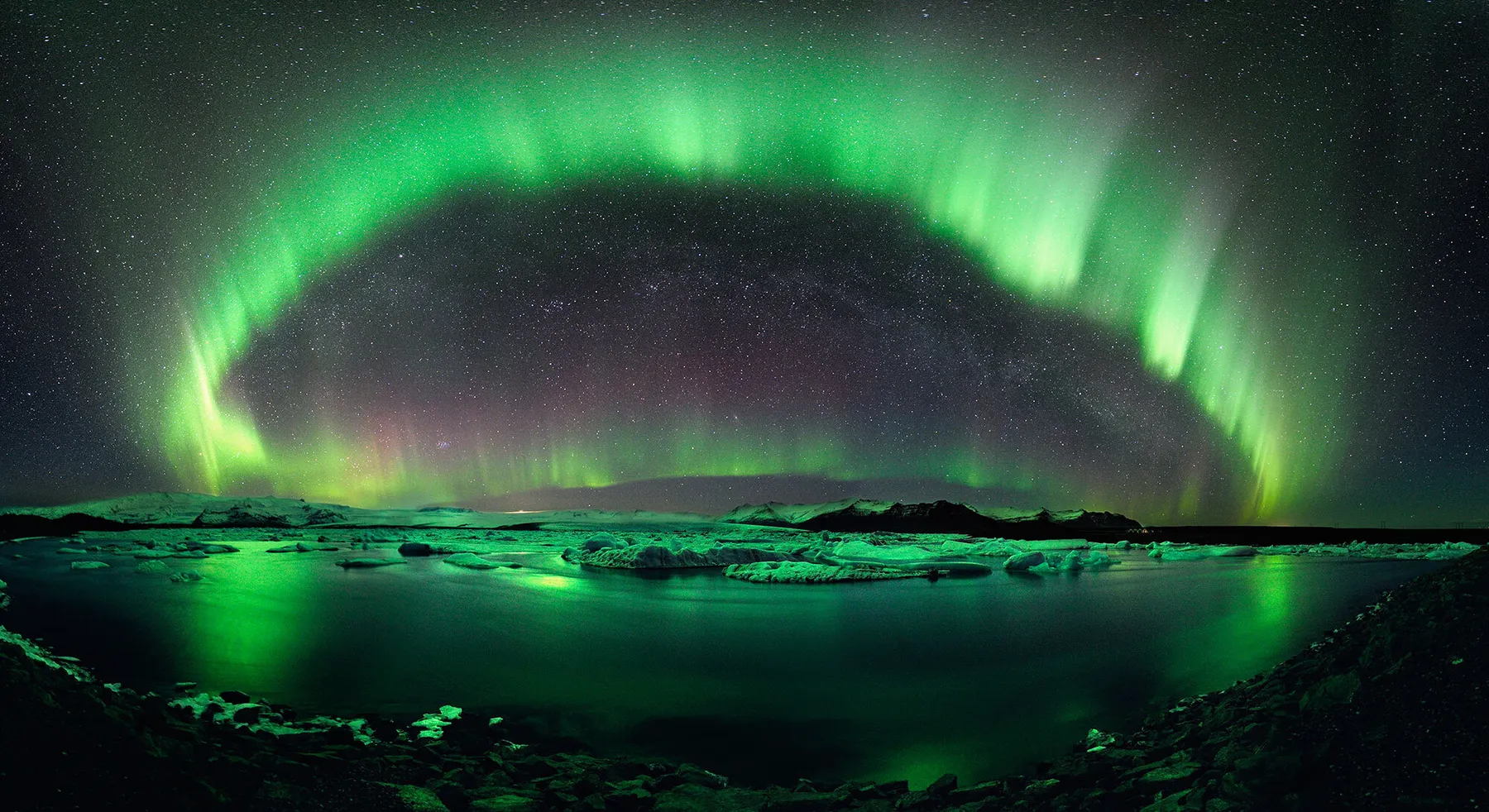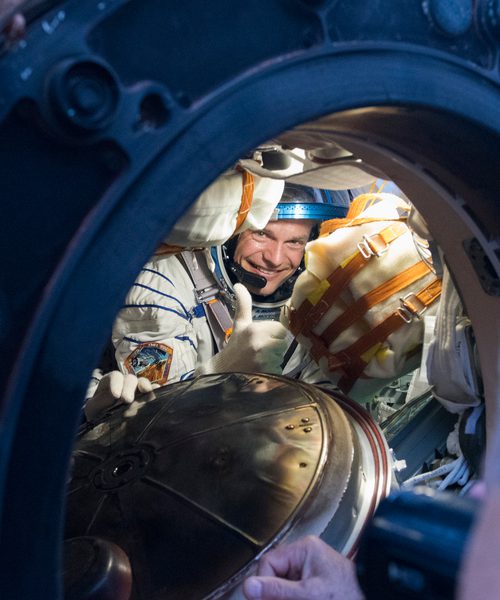
Aurora
Aurora is undoubtedly one of the most interesting and spectacular natural phenomena we can experience here on Earth, but what is it and how can you observe it?
Magnetic field creates light show
In Norse mythology, it was explained that the beautiful colour patterns in the sky were a fence built by the gods to keep the giants out of Midgard - the human world. The fence was built from the eyelashes of the dead primeval giant Ymer.
Today, we know that the Northern and Southern Lights are created when electrically charged particles from the Sun hit the Earth's magnetic field, but that doesn't make it any less spectacular.
Aurora (northern and southern lights) occur when electrically charged particles flow towards the Earth. When the particles reach the Earth's north and south poles, the air in the part of our atmosphere that lies approximately 90-500 kilometres above the Earth's surface begins to glow.
The particles have either been trapped in the Earth's magnetic field or come from the Sun. There is always aurora around the North and South Poles, but when there are many particles from the Sun or very strong disturbances in the Earth's magnetic field, the aurora can extend further south.
Solar storms shoot particles towards Earth
The Sun emits a constant stream of protons and electrons. This is called the solar wind. The particles have an average speed of 350 km/s, but closer to the Sun the particles flow faster - up to several thousand kilometres per second.
Disturbances in the Earth's magnetic field can occur when the field is hit by enormous clouds of electrically charged particles ejected from the Sun during solar flares.
Where can you see aurora?
When the particles arrive on Earth, they are first met by the Earth's magnetic field and travel along it towards the magnetic poles. Therefore, the closer you are to the poles, the more likely you are to see aurora.
Close to the poles, the northern and southern lights are seen as large undulating carpets, while further away from the polar regions they can be seen as rays because the magnetic field is different. The light can move quickly across the sky or appear to stand still and blink. In Denmark, the Northern Lights are often seen as a very faint, diffuse cloud on the horizon.

Intensity varies
The sun has a very hot part of its atmosphere called the corona. In this layer of the atmosphere, holes can form due to magnetic disturbances. When these holes appear, the magnetic field is no longer able to hold on to the many particles in the atmosphere and they start to flow out through the corona hole. The particles are travelling at a very high speed as they leave the Sun. Such a fast flow of particles will catch up with the particles previously emitted from the Sun and a shock wave can be formed.
When such a wave passes the Earth, it will affect the Earth's magnetic field and weaken it. It will no longer protect our atmosphere as well and we will see the atmosphere being bombarded by particles from the current and there may be an increased chance of Northern Lights.
Solar flares
There are several different types of solar flares that cause more aurora on Earth. There are what are called CMEs (Coronal Mass Ejections), which are large plasma eruptions from the Sun that eject large amounts of plasma from the Sun's atmosphere into the solar system. These eruptions travel at thousands of kilometres per second and are one of the most powerful energy discharges in our solar system.
There are also solar flares, which are called flares. They occur when energy accumulated in intricate parts of the Sun's magnetic field (around large sunspot groups) is suddenly released. A lot of X-rays are usually emitted during flares.
In 1989, there was a flare so powerful that it could be seen with the naked eye from Earth. The flare was observed by Richard C. Carrington, who also gave his name to the event. The flare was so powerful that about 17.5 hours later, auroras could be seen as far south as the Caribbean Islands and south of the Sahara. Southern lights could be seen as far south as Queensland in northern Australia. The event caused several telegraph stations to short circuit.
It's the atmosphere that glows
You might think that it's particles from the Sun that light up when you see the Northern Lights in the sky, but that's not actually the case. It's molecules in the atmosphere that glow. When they are hit by the electrically charged particles from the Sun, they enter what is called a higher energy state. They gain more energy. But the molecules can't stay in that state for long and fall back to their old energy state. When they do, they emit light - aurora.

Observation tips
There are a number of things to be aware of when looking for the Northern Lights.
- The space weather forecast to find out how active the Sun is and has been
- The general weather forecast to find out if there is a clear view of the sky
- Your physical and geographical location
- In addition, it usually requires warm clothes and a lot of patience
DTU Space has a great overview of what they call space weather. Here you can see the probability of solar flares and computer simulations of the last major solar flare. You can also see a current image of what is called the auroral oval. This is the area in the atmosphere where the Northern Lights are present.
As is always the case when looking at the night sky, it's important to find a dark place away from the city lights. When looking for northern lights, north-facing coasts can be a good starting point. You're usually far away from city light pollution and you usually have a good view of the northern horizon.
On the website of the Danish Society for Nature Conservation you can see a list of the darkest places in Denmark.
The best observation opportunities are in the northern part of the country with good views of the northern horizon.
Northern lights in Denmark
Denmark is very southern when it comes to Northern Lights, but you may be lucky enough to catch a glimpse of the coloured waves in the sky.
Links about aurora
The space weather forecast from both DTU Space and the US National Oceanic and Atmospheric Administration, NOAA.
DTU Space Weather
NOAA Space Weather
SpaceWeatherLive
THE NIGHT SKY IN GENERAL
See when the International Space Station can be seen from Denmark.
spotthestation.nasa.gov
The programme Stellarium can be used online or downloaded for free to see what the starry sky looks like at different times and from locations all over the world.
stellarium.org
The best Northern Lights images from the Insight Investment Astronomy Photographer of the Year 2019 competition in the category Aurora.
rmg.co.uk
APPS FOR THE NIGHT SKY
Google Skymap - helps navigate the starry sky.
play.google.com
StarWalk - use your phone to see which constellations and stars you are looking at.
IOS
ANDROID
Aurora Forecast - here you can see which places in Scandinavia have the best chance of seeing the Northern Lights.
IOS
ANDROID
Aurora Now - shows the Sun's activity and the probability of Northern Lights in your area.
IOS
ANDROID






